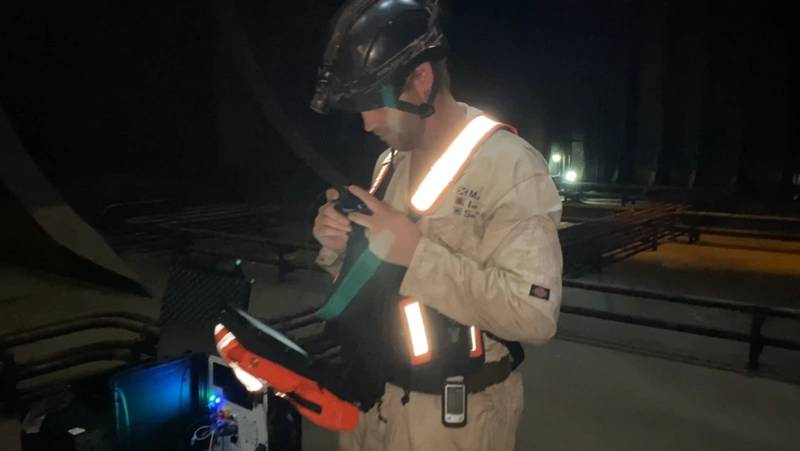Enclosed Spaces: Engineering Solutions
If you think the human element is the only cause of enclosed space deaths, think again.
Enclosed space incidents are cited as the largest cause of on-duty fatalities in commercial shipping. The risks can’t simply be engineered out, but there’s a powerful coalition wanting action nonetheless.
There’s a tendency to blame failure to follow procedures, they say. Investigations seldom focus on the practicality of those procedures or the influence of the operating environment and vessel design, they say. Currently, IMO guidelines are just that, guidelines, and they can be interpreted differently by different shipping segments.
Paul Markides, Marine-Quality Manager at INTERCARGO, notes that even the definition of what is an enclosed space can vary. On LNG carriers, there is a case for not designating compressor rooms as enclosed spaces as people enter them so regularly. It would be an inconvenience to have to fill out a permit and test the atmosphere every time. “So what? Inconveniences are a necessity of life.”
Having inbuilt detection systems would be a step forward, he says. However, beyond the initial expense, there is also the need for testing, calibration and maintenance. “You might not get that investment from owners until the IMO makes them mandatory.”
INTERCARGO is part of the coalition trying to make change happen. Members of the Human Element Industry Group (HEIG) also include International Chamber of Shipping, OCIMF, International Marine Pilots Association, International Federation of Ship Masters’ Associations, Institute of Marine Engineering Science and Technology (IMarEST), InterManager, the Royal Institute of Naval Architects (RINA), International Christian Missions Association, International Transport Workers Federation and The Nautical Institute.
Martin L Shaw, President of the IMarEST, says HEIG made a submission to the IMO in June about the classification of enclosed spaces based on hazards and risks that should form the basis for procedures and regulations. HEIG has also submitted an update to the IMO 1050(27) Revised Recommendations for Entering Enclosed Spaces Aboard Ships.
“I don’t believe there has ever been a ship that was designed to be safe from the point of view of enclosed space entry,” says Shaw.
The use of Australian ladders, which were designed to reduce ‘fall from height’ risks at loading ports are an example. In some designs, these ladders were enclosed creating a trapped atmosphere once the cargo is loaded. This can result in fatalities at the discharge port.
HEIG has produced the Systemic Analysis and Reduction of Enclosed Space Hazards in the Design of Ships and Systems (SARESH) – defining a hierarchy of hazard control and providing guidance on reducing the risks through engineering solutions. It has also produced Technical Solutions to Enclosed Space Fatalities.
 "I don’t believe there has ever been a ship that was designed to be safe from the point of view of enclosed space entry." Martin L Shaw, President, IMarEST
"I don’t believe there has ever been a ship that was designed to be safe from the point of view of enclosed space entry." Martin L Shaw, President, IMarEST
Designers could aim to avoid the need for entering an enclosed space at sea: drydock entry reduces the risk as the ship should be in a safer, more planned and predictable environment. Achieving this would involve avoiding the need to fit equipment in enclosed spaces, enabling its removal for maintenance and repairs or ensuring it requires minimal or no maintenance between drydocking.The International Association of Classification Societies has robust procedures for enclosed space entry, and many states have national requirements as well, but HEIG sees the need for an integrated review of PPE for enclosed space entry, as it is often a collection of mismatched equipment that does not fit comfortably and may not operate correctly.
The relocation and expansion of access holes might be a mitigating engineering change that would be easily achievable in drydock. Access arrangements should allow for a rescue party wearing SCABA and for casualty lifting equipment. Access for ventilation could be remote from the manhole, and fixed ventilation could be provided in cases where regular access is required.
The use of drones could reduce the need for enclosed space entry. This technology is being developed by several class societies including the REDHUS project involving DNV, NTNU, shuttle tanker owner Altera, bulk ship operator Klaveness and robotics company ScoutDI. The group is furthering the development of beyond visual line-of-sight (BVLOS) operation for inspections without human entry. Equipping a team with an indoor inspection drone reduces the number of people required and makes inspections faster. If they choose to enter the space, fewer people will be exposed for a shorter time.
Ship designs should be reviewed with the aim of reducing the number of enclosed spaces. Still, it’s easier said than done. The simplicity of the cargo tank in a double hull tanker, for example, is offset by the complexity of adjacent ballast tanks.
Sarah Watts, Chairman of the RINA Safety Committee, points out that naval architects are often criticized for poor design, but it should be recognized that they have to work within many constraints, including compliance with regulations and the specification and wishes of shipowners and shipyards. The fit-out of ships may involve contractors routing pipes and cables through the internal structure with little consideration of how they restrict access inside the space.
Watts points to the physiological risk that there is no bodily response to low oxygen, rather it is high CO2 concentration that causes the ‘out of breath’ sensation. “If you walk into a room of 100% nitrogen, you will most likely never notice the lack of oxygen before you die.”
The hazard that a small opening poses is usually obvious. Cargo holds with large openings but atmosphere depleting properties from cargoes such as coal are not so obvious. “It is possible that in these instances the size of the hatch actually hides the problem.” And, she says, the alternative to eliminating enclosed spaces is to reduce the number of them which might then reduce the training given, which would potentially exacerbate the problem.
However, Watts recognizes that more can be done on design, and along with HEIG, RINA is involved with the industry consortium Together in Safety, a non-regulatory industry consortium connecting the maritime sector with the common purpose of working together to improve safety. Naval architects need to take account that the design allows for safe operation, she says. “If the design does not allow for safe operation; it is simply bad design.”
 "If you walk into a room of 100% nitrogen, you will most likely never notice the lack of oxygen before you die." - Sarah Watts, Chairman, RINA Safety Committee
"If you walk into a room of 100% nitrogen, you will most likely never notice the lack of oxygen before you die." - Sarah Watts, Chairman, RINA Safety Committee

















